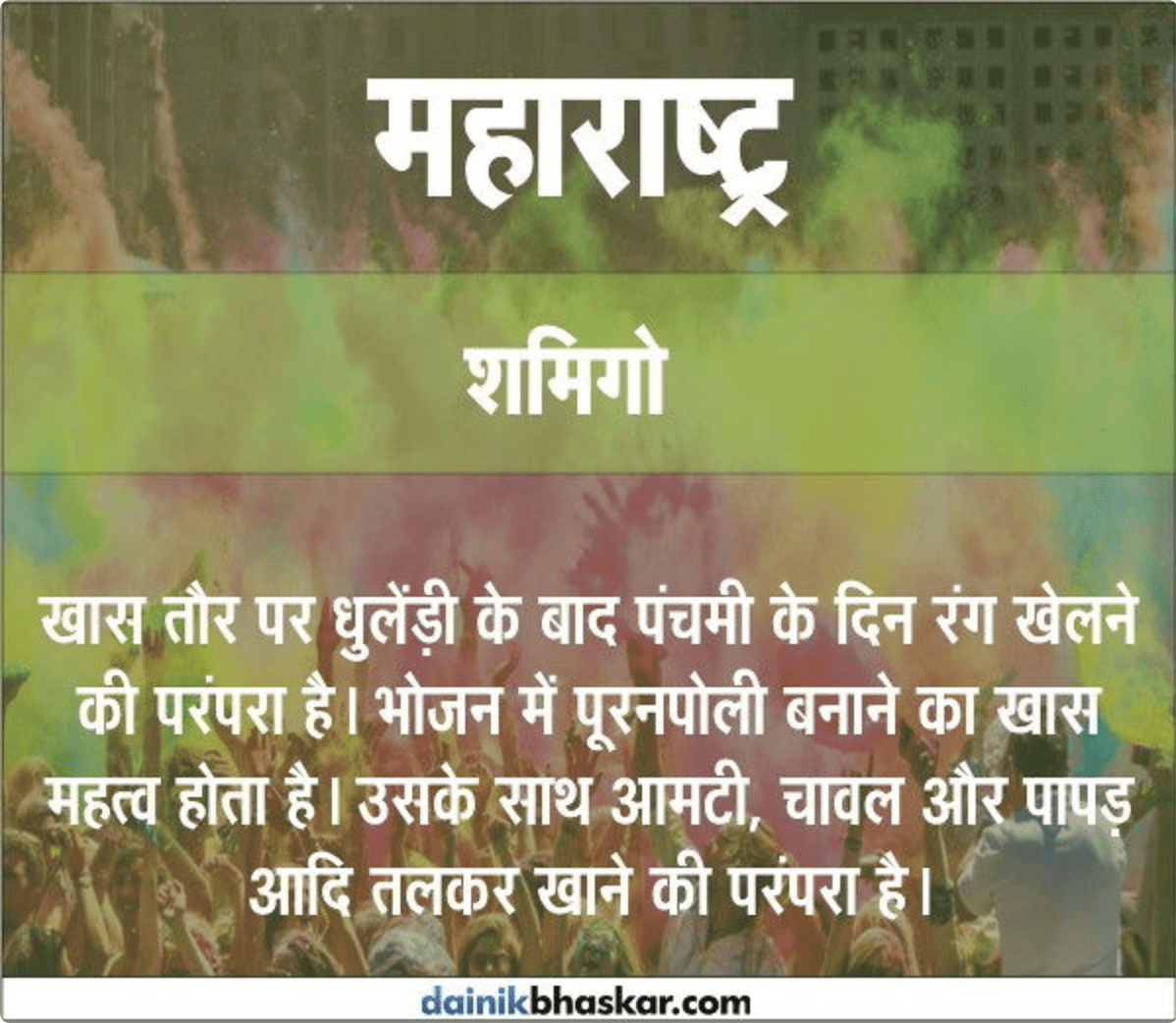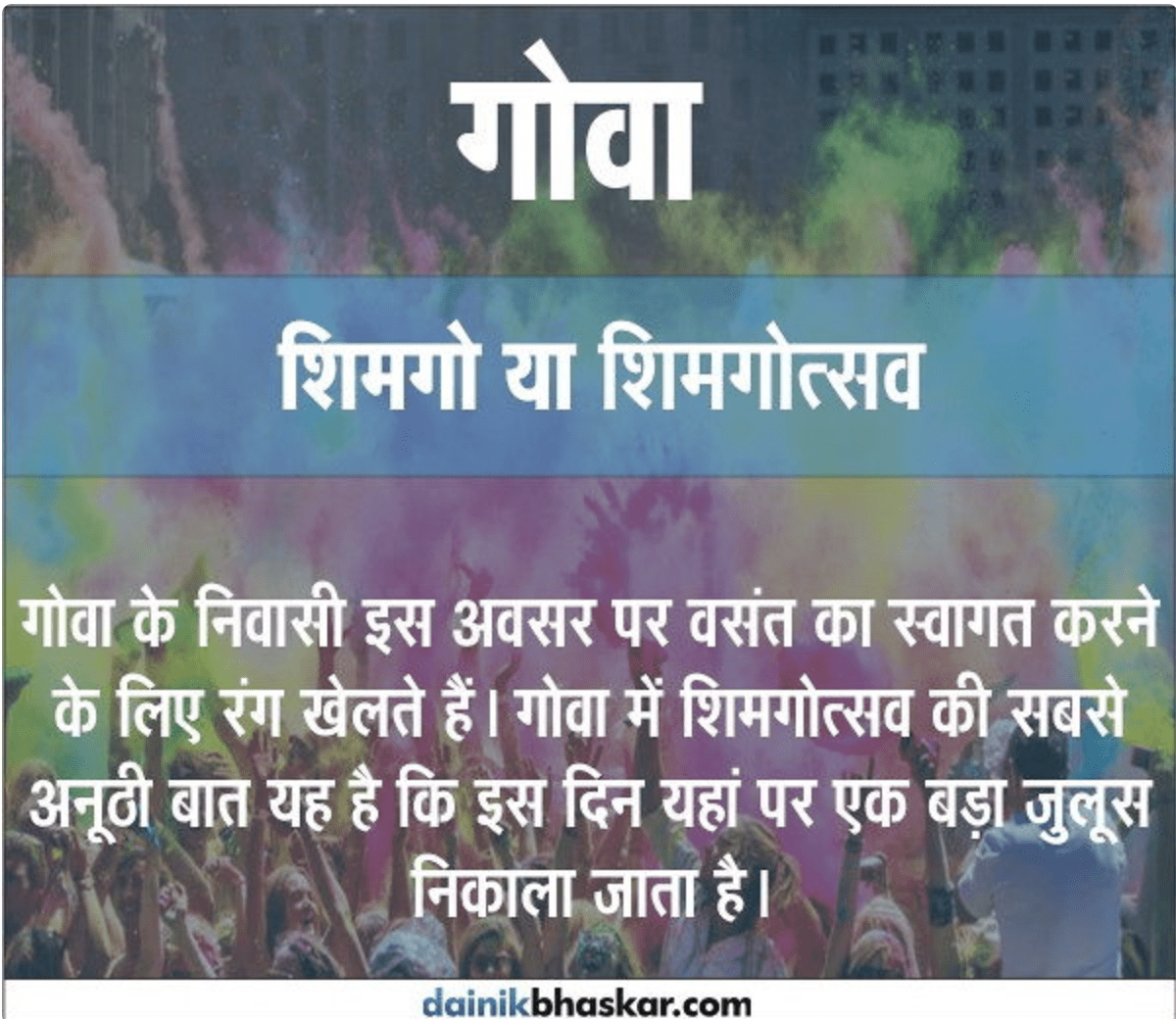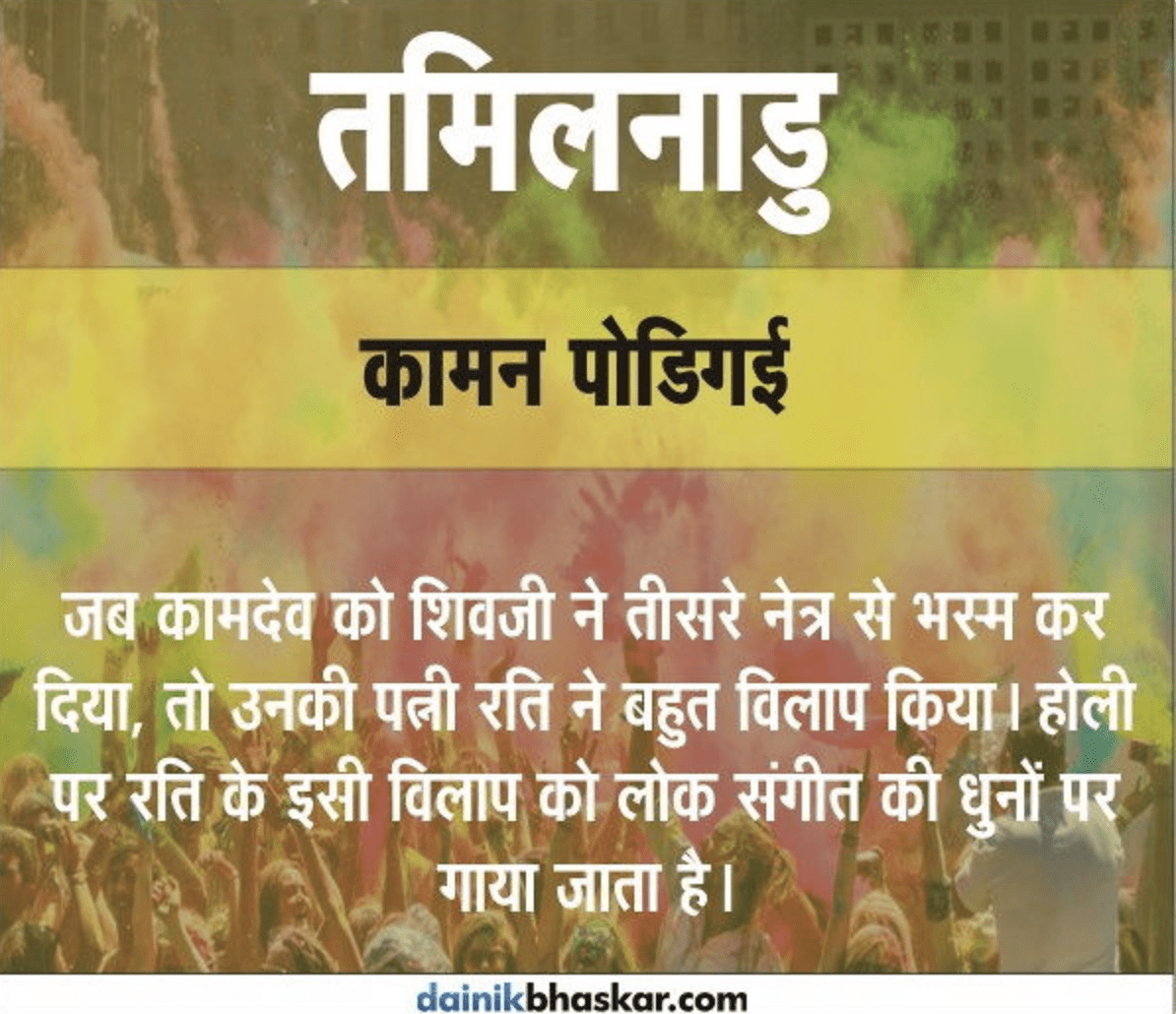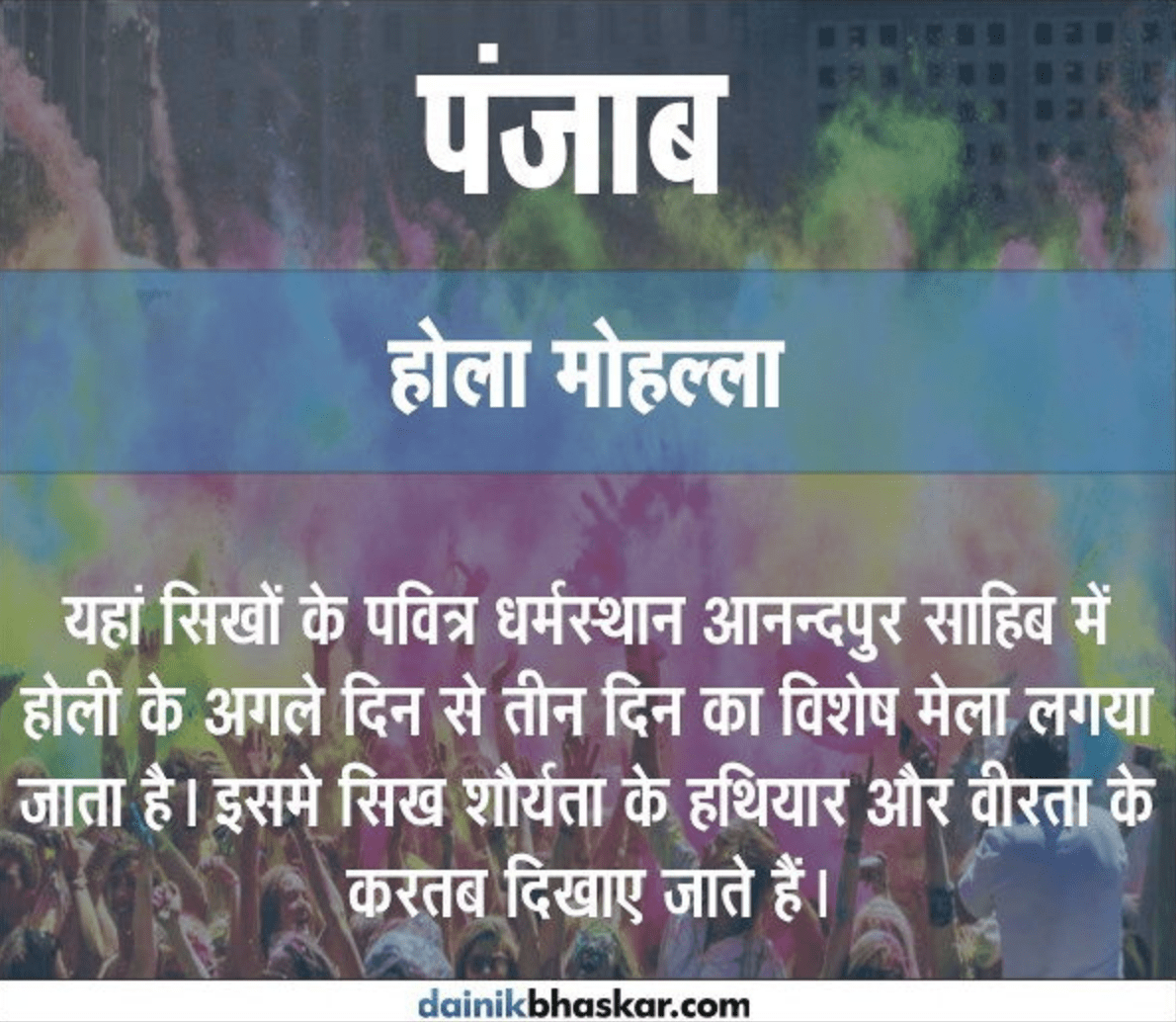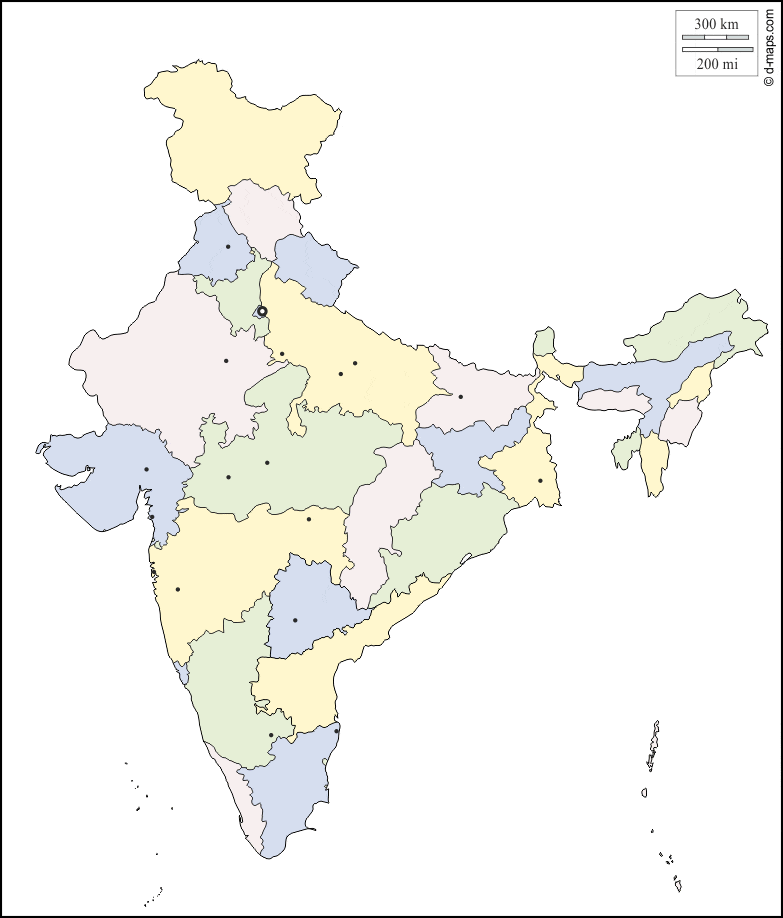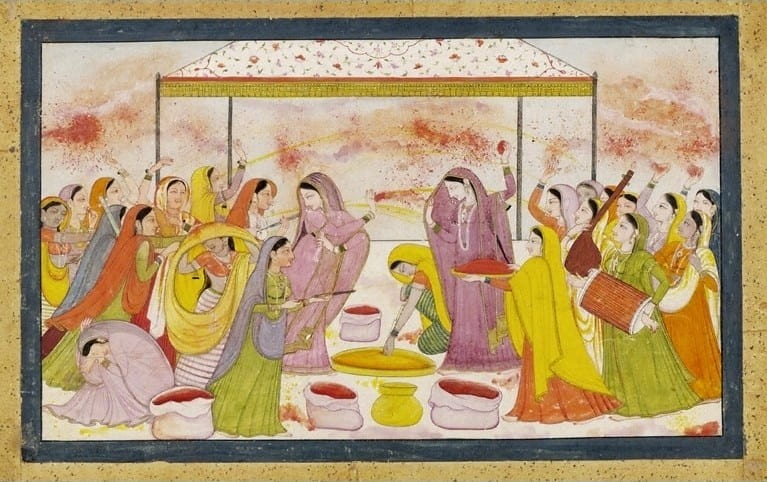 Based on a lesson plan prepared by Rajni Bhargava and with assistance by Sarfaraz Farooque and Utsab Ray.
Based on a lesson plan prepared by Rajni Bhargava and with assistance by Sarfaraz Farooque and Utsab Ray.
Proficiency Level: Intermediate Mid; Time: 6X75 min.
Objectives: Students will be able to:
Identify and explain the cultural products and practices of Holi (higher level students work on a homework focused on the perspectives — the story of Holi )
Compare and contrast Holi celebrations in different parts of India
Language Targets: Students learn the use of:
passive voice: त्यौहार मनाया जाता है, होली मनायी जाती है
कर construction
compound verbs: होली शुरू हो जाती है
nominal conjunct verbs — emphasis is on the object of the verb in the corresponding English sentence, which is marked with a postposition (typically का,की, or less often से): का प्रयोग करना, की कोशिश करना, का स्वागत करना, का प्रदर्शन करना
Performance Tasks:
Interpretive: View and fill out a concept map Interpersonal: Fill out a Venn diagram comparing and contrasting the way the celebration is conducted in different parts of India (students are experts of 1 or 2 states and learn from their group partners about other states)
Interpersonal: Fill out a Venn diagram comparing and contrasting the way the celebration is conducted in different parts of India (students are experts of 1 or 2 states and learn from their group partners about other states)
Presentational: Students prepare a ppt slide using a blank map of India with voice over and animation.
Zoom classroom learning scenarios:
1. The teacher introduces the topic of Holi by sharing the screen with a few Holi photos. Students brainstorm on what they know and can say about the festival of Holi. They work in assigned breakrooms. They share with the whole group and identify one aspect/element of Holi they did not know about which they heard from their peers. The class builds a word bank.
https://www.bbc.com/hindi/media-43246995
2. To expand what they know about Holi, the teacher shares screen and shows them a clip to view (with no narrative). In small groups, they orally describe what they see. The teacher supports their group-work and expands the word bank.
Teacher re-assigns students to new breakout rooms and they share what they came up with the previous group.
 For homework: They organize all the information they accumulated on a concept map. They record their explanation and upload on the Forum. (If feasible, they are asked to check at least 2 of their peers maps and note down which idea they like and will add to their map).
For homework: They organize all the information they accumulated on a concept map. They record their explanation and upload on the Forum. (If feasible, they are asked to check at least 2 of their peers maps and note down which idea they like and will add to their map).
3. Teacher shares screen for students to view:
a) a video clip of how Holi is celebrated in India (glossary)
b) song on Holi from the film Sholay (0.05 – 1.00) (glossary)
Teacher checks for understanding by asking guiding questions (लोग क्या करते हैं, सड़क पर क्या होता है? ). Then teacher shows a google document with main structures and vocabulary, and shares it with the students. Each student writes onto the google document 2 sentences with the use of each new structure and at least 2 new vocabulary items (कर construction and simple compounds).
4. Jigsaw activity: Individually, students are assigned to read excerpts about Holi (article1 and article2), and/or two slides from a site on Holi describing how Holi is celebrated in different parts of India. They first scan for target structures in their excerpts and copy them in a table with two columns. Then they read for gist about states/places in India they are assigned. Then they are put in groups and they share the information with other students. They compare and contrast different information of how Holi is celebrated in different places/states of India using a table or a Venn diagram.
[gview file=”https://bpb-us-e1.wpmucdn.com/wp.nyu.edu/dist/e/3394/files/2020/03/School-Venn-Diagram-PDF-Format.pdf”]
Text from article1 and article2 and slides from site (color coded for group assignment)
1. ब्रज की होली: भारत में सबसे ज्यादा मशहूर है ब्रज की होली। ब्रज की होली को लट्ठमार होली कहा जाता है। खासतौर पर यह मथुरा,वृंदावन और बरसाना के इलाकों में खेली जाती है। यहां पर महिलाएं लाठी से पुरुषों की पिटाई करती हैं जबकि पुरुष उनसे बचने की कोशिश करते हैं और उनसे बचते हुए उन पर रंग लगाते हैं। । रंग-गुलाल से सजी होली का स्वागत विभिन्न क्षेत्रों के लोग अपने-अपने तरीके से करते हैं। वहीं कुछ स्थानों पर होली मनाने की परंपरा तो देश-विदेश में भी लोगों को आकर्षित करती है। कृष्ण और राधा के प्रेम के प्रतीक मथुरा-वृंदावन में होली की धूम 16 दिनों तक छाई रहती है, जिसमें इनके दैवीय प्रेम को याद किया जाता है। कहते हैं बचपन में कृष्ण राधा रानी के गोरे वर्ण और अपने कृष्ण वर्ण का कारण माता यशोदा से पूछा करते थे। एक बार उन्हें बहलाने के लिए माता यशोदा ने राधा के गालों पर रंग लगा दिया। तब से इस क्षेत्र में रंग और गुलाल लगाकर लोग एक-दूसरे से स्नेह बांटते हैं।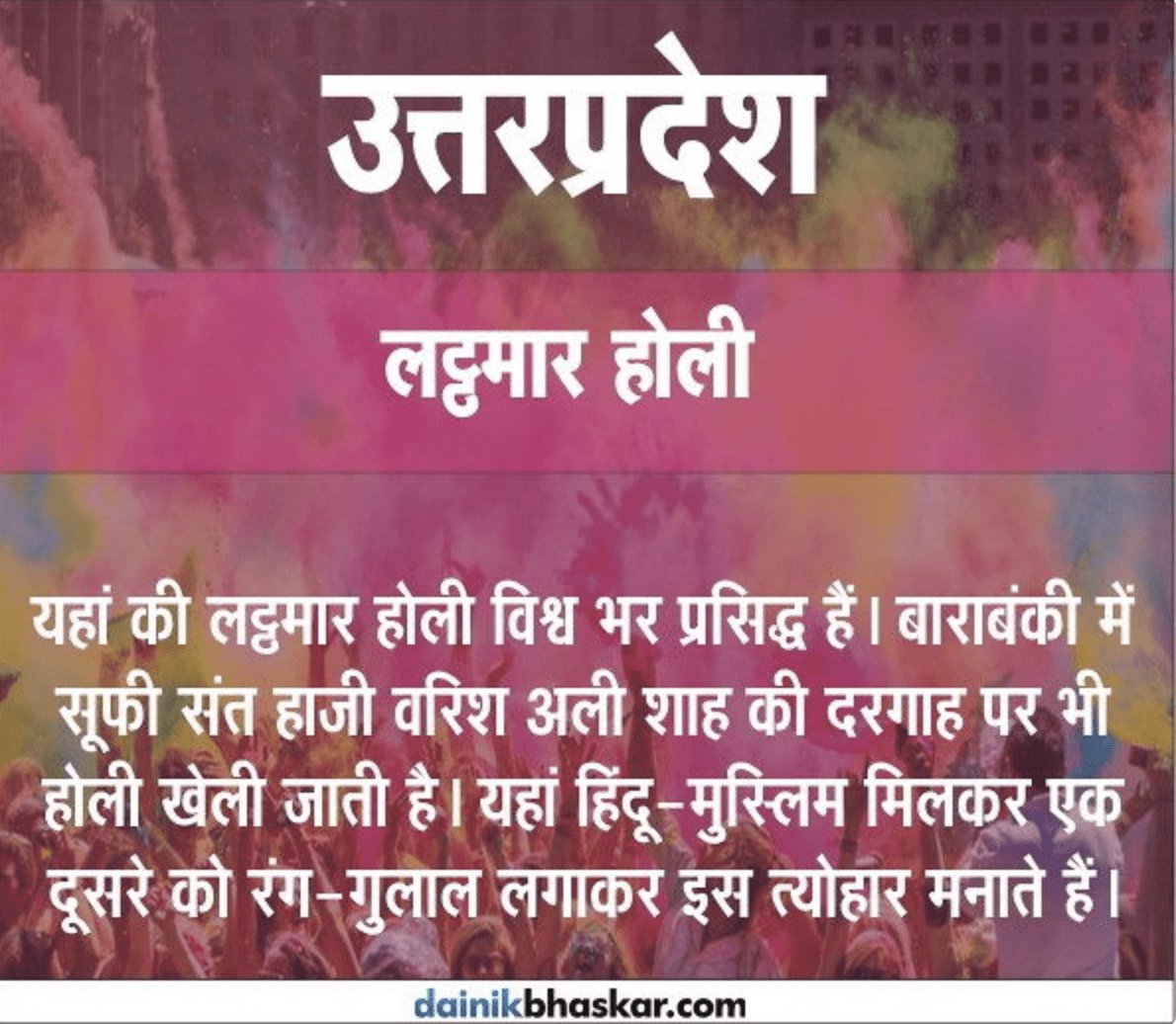
- मशहूर – famous
- लट्ठमार – stick-beating
- खासतौर पर – especially
- इलाका m. – area, neighborhood
- महिला f. – woman
- लाठी f. – stick
- पुरुष m. – man
- X की पिटाई करना – to beat X
- X का स्वागत करना – to welcome X
- परंपरा f. tradition
- X को आकर्षित करना – to attract X
- धूम f. – clamor
- दैवीय प्रेम – divine love
- Xको याद करना – to remember X
2 कुमाउ की होली: उत्तराखंड के कुमाउ क्षेत्र में हर साल कुमाउनी होली बड़ी धूम-धाम से मनाई जाती है। यहां मौजूद सभी लोगों के लिए यह त्योहार एक ऐतिहासिक और सांस्कृतिक उत्सव है। कहते हैं यहां होली की खुमारी लोगों में करीब दो महीनों तक रहती है। यहां पर होली विभिन्न प्रकार के संगीत समारोह के रूप में मनाई जाती है, जिसे बैठकी होली, खड़ी होली और महिला होली के नाम से भी माना जाता है।
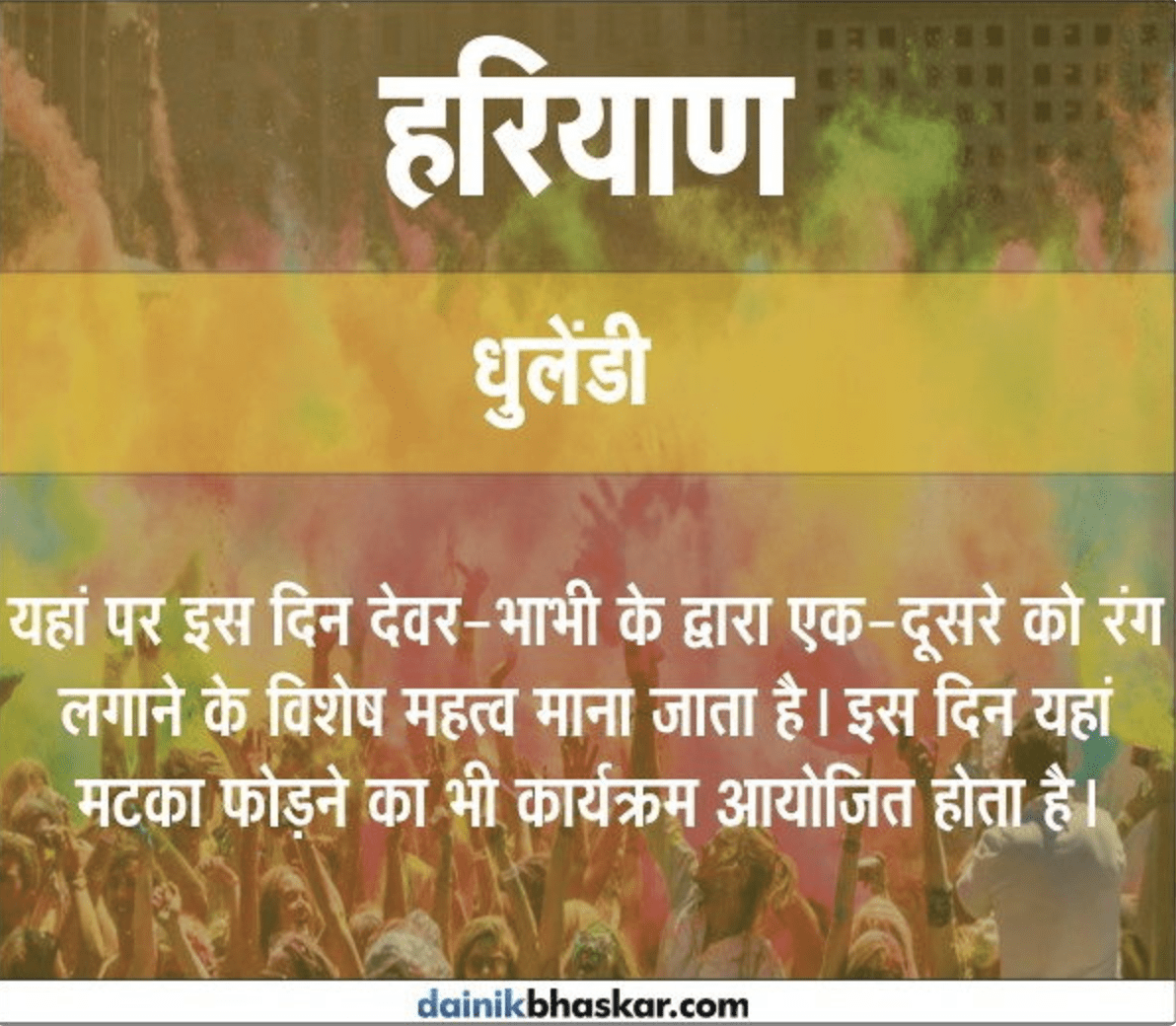 हरियाणा की होली: हरियाणा की धुलेंडी में भाभी द्वारा देवर को परेशान करने की प्रथा है। यह देशभऱ में प्रसिद्ध है। वहीं हरियाणा में होली (धुलेंडी) के दौरान भाभी-देवर के रिश्ते की मिठास की अनोखी मिसाल दिखती है, जब भाभियां अपने प्यारे देवरों को पीटती हैं और उनके देवर सारे दिन उन पर रंग डालने की फिराक में होते हैं। भाभियों का यह प्यारा सा बदला इस क्षेत्र में होली को ‘धुलेंडी होली’ का नाम देता है।
हरियाणा की होली: हरियाणा की धुलेंडी में भाभी द्वारा देवर को परेशान करने की प्रथा है। यह देशभऱ में प्रसिद्ध है। वहीं हरियाणा में होली (धुलेंडी) के दौरान भाभी-देवर के रिश्ते की मिठास की अनोखी मिसाल दिखती है, जब भाभियां अपने प्यारे देवरों को पीटती हैं और उनके देवर सारे दिन उन पर रंग डालने की फिराक में होते हैं। भाभियों का यह प्यारा सा बदला इस क्षेत्र में होली को ‘धुलेंडी होली’ का नाम देता है।
- क्षेत्र m. – area
- बड़ी धूम-धाम से – with big pomp/splendor
- मौजूद – present
- त्योहार m. = उत्सव m.
- ऐतिहासिक – historical
- सांस्कृतिक – cultural
- विभिन्न प्रकार m. – various types
- संगीत समारोह m. – song festival
- Xको परेशान करना – to bother X
- प्रथा f. – tradition
- प्रसिद्ध – famous है
- मिठास m. – sweetness
- Xकी अनोखी मिसाल f. – unique example of X
- की फिराक में होना – in search of X
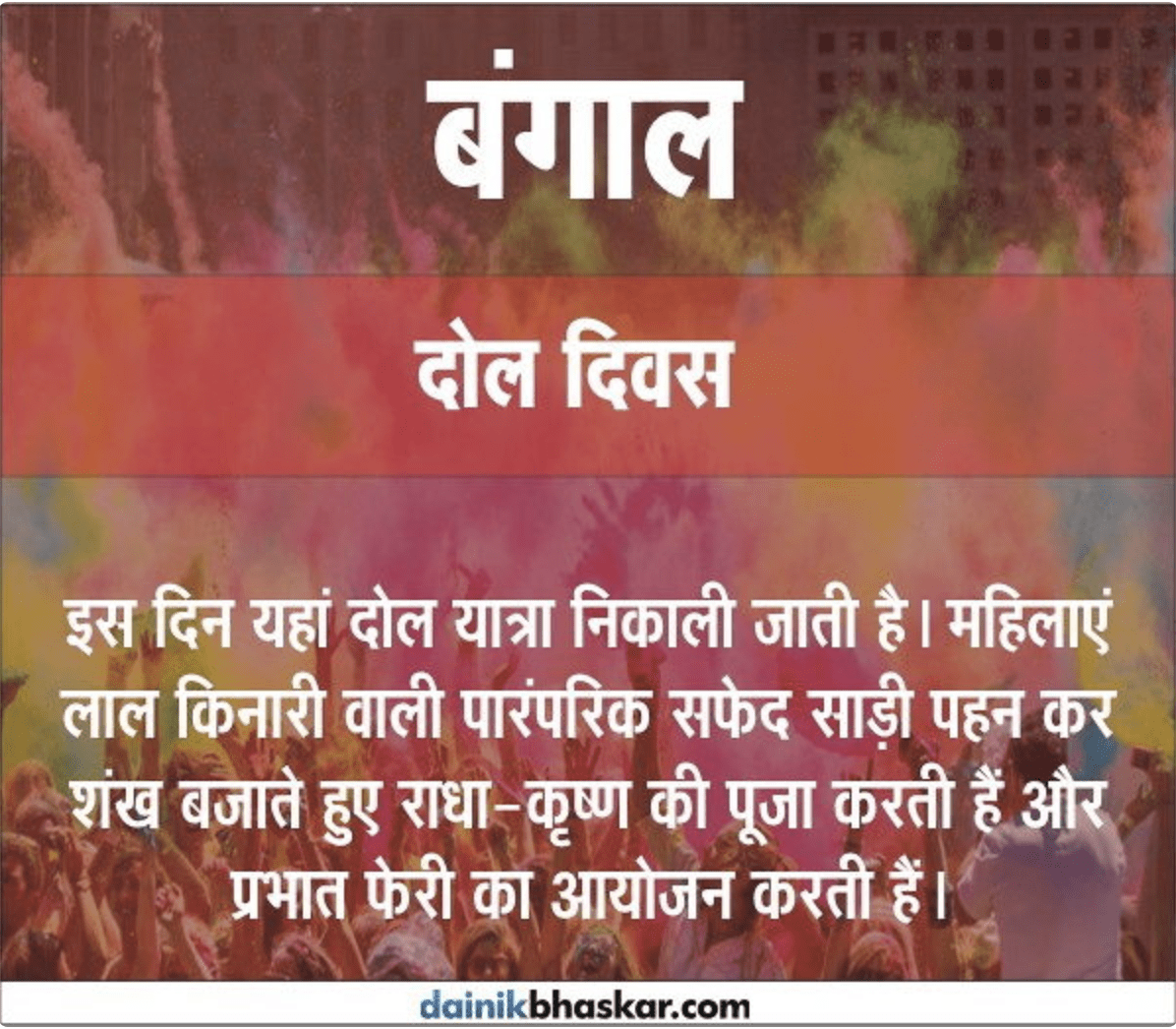
3. बंगाल की होली: बंगाल की दोल जात्रा चैतन्य महाप्रभु के जन्मदिन के रूप में मनाई जाती है। यहां होली के अवसर पर ज्यादातर लोग सिर्फ सूखे रंग का ही इस्तेमाल करते हैं। बंगाल में होली का ‘डोल पूर्णिमा’ नामक स्वरूप बेहद प्रचलित है। इस दिन का महत्व इसलिए भी बढ़ जाता है क्योंकि इस दिन को प्रसिद्ध वैष्णव संत महाप्रभु चैतन्य का जन्मदिन माना जाता है। डोल पूर्णिमा के अवसर पर भगवान की अलंकृत प्रतिमा का दल निकाला जाता है और भक्तगण पूरे उत्साह के साथ इस दल में भाग लेते हैं और हरि की उपासना करते हैं। वहीं गुरुदेव रवीन्द्रनाथ टैगोर द्वारा स्थापित शांति-निकेतन में होली को ‘वसंत उत्सव’ के रूप में मनाया जाता है।
बिहार की होली: बिहार में होली के मौके पर गाये जाने वाले फगुआ की अपनी गायन शैली के लिए अलग पहचान है। राज्य में कई स्थानों पर कीचड़ से होली खेली जाती है तो कई स्थानों पर कपड़ा फाड़ होली खेलने की भी परंपरा है। होली के दिन रंग से सराबोर लोग ढोलक की धुन पर नाचते है और लोकगीत गाते हैं।
- X के अवसर पर = के मौके पर – on the occasion of X
- ज्यादातर लोग – most people
- X का इस्तेमाल करना – to use X
- नामक स्वरूप – with the name of
- बेहद – boundless
- प्रचलित – popular
- का महत्व m. – X’s importance
- अलंकृत – decorated
- प्रतिमा f. – image or statue
- दल m. – group
- भक्तगण – the community of all followers (congregation)
- पूरे उत्साह के साथ – with enthusiasm
- X में भाग ले – to participate in X
- Xकी उपासना करना – to worship X
- ‘वसंत उत्सव’ – spring festival
- फगुआ = फागुन – name of a style of Holi songs
- गायन शैली f. – song style
- पहचान f. recognition, identity
- फाड़ना – to tear हो
- परंपरा f. – traditionहै
- रंग से सराबोर लोग people wet with the colors
- ढोलक की धुन पर – with the beat of the (two-sided) drum
4. महाराष्ट्र की रंगपंचमी में सुखा गुलाल खेलने, गोवा में शिमगो व पंजाब में होला मोहल्ला में सिक्खों द्वारा शक्ति प्रदर्शन की प्रथा है।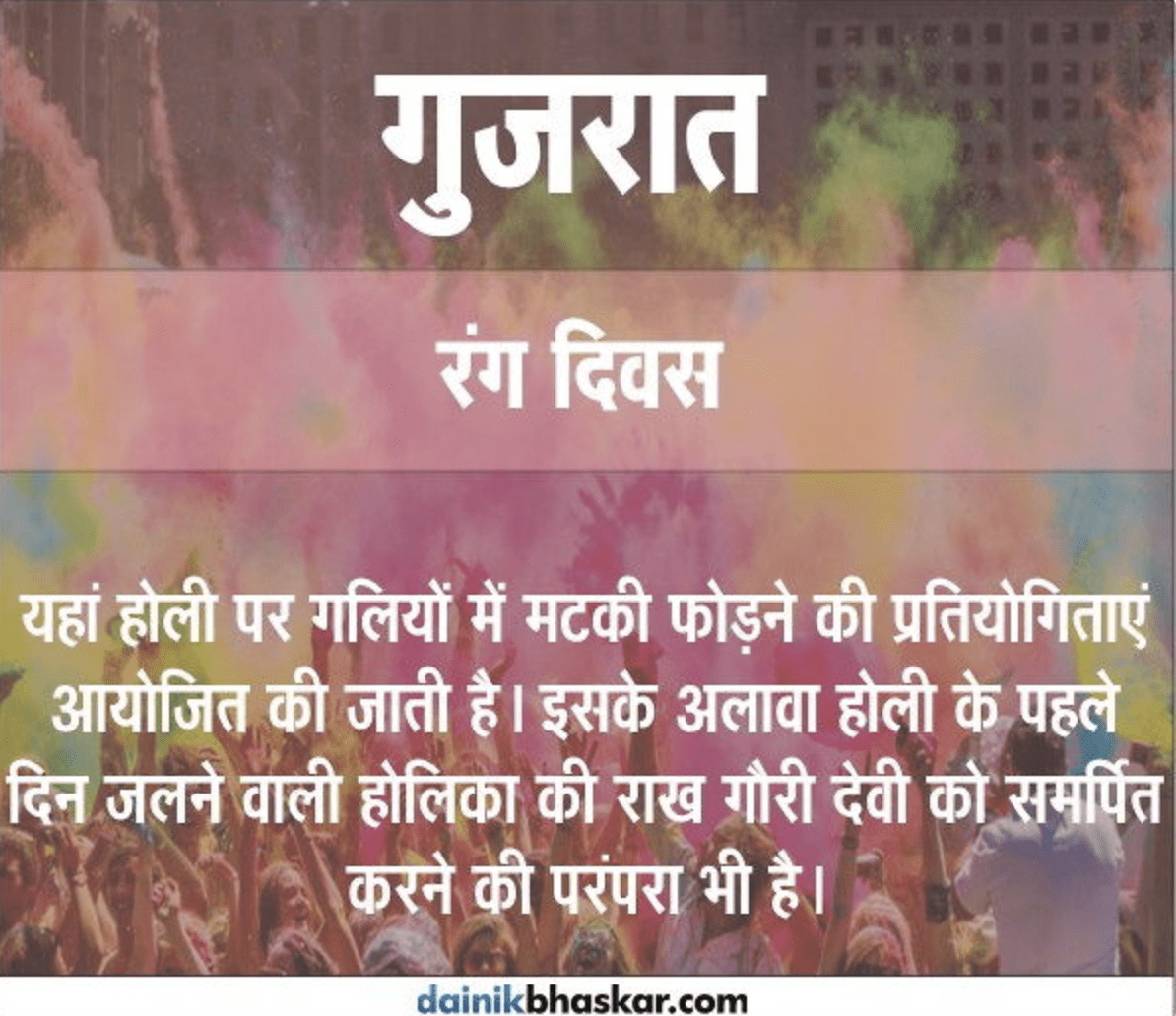
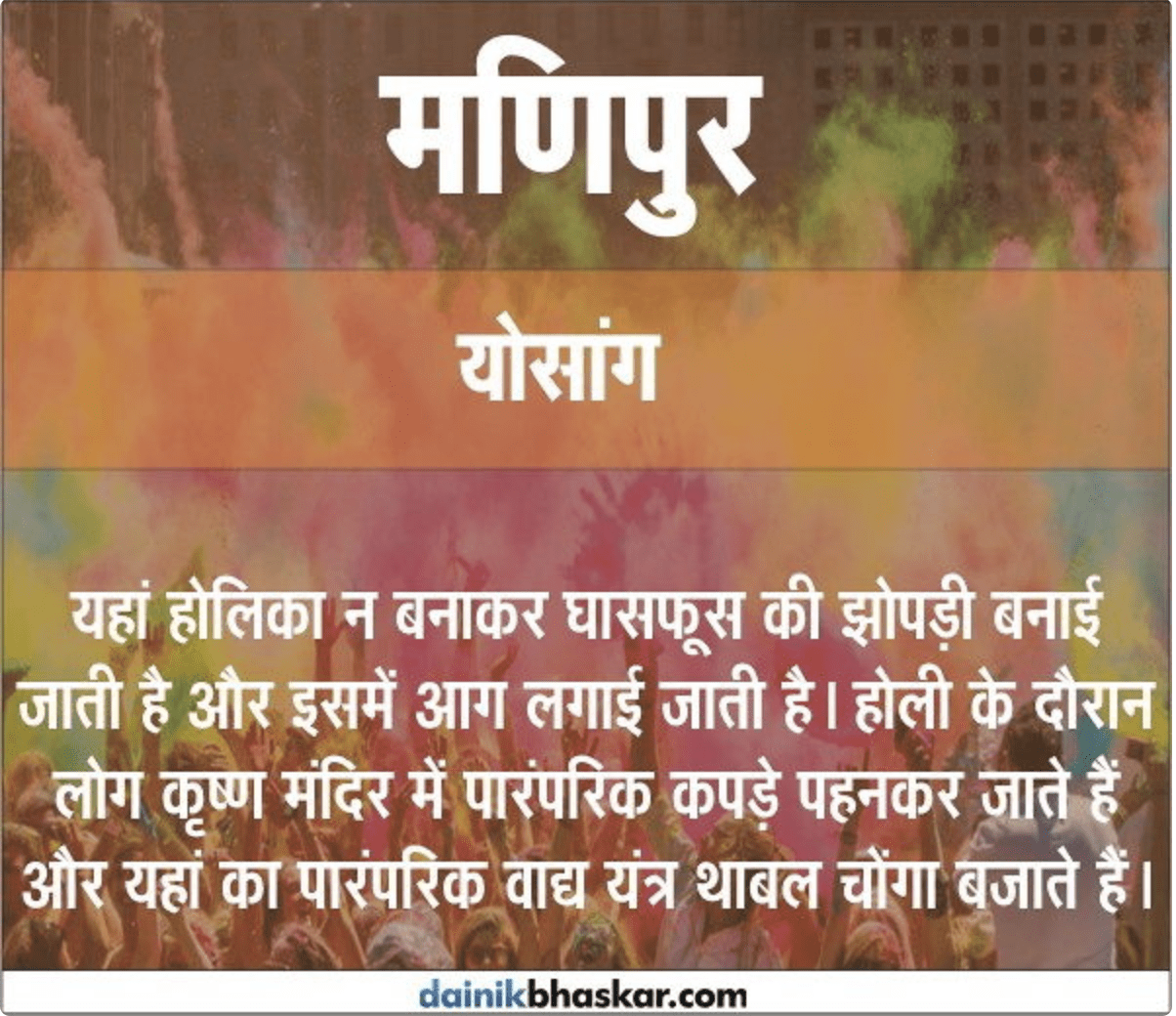 मणिपुर की होली : देश का हर कोना होली के रंगों से रंगा हुआ है। मणिपुर में यह रंगों का त्योहार छः दिनों तक मनाया जाता है। साथ ही इस पर्व पर यहां का पारंपरिक नृत्य ‘थाबल चोंगबा’ का आयोजन भी किया जाता है। इस तरह से होली का यह पर्व पूरे देश को प्रेम और सौहार्द के रंग में सराबोर रखता है।
मणिपुर की होली : देश का हर कोना होली के रंगों से रंगा हुआ है। मणिपुर में यह रंगों का त्योहार छः दिनों तक मनाया जाता है। साथ ही इस पर्व पर यहां का पारंपरिक नृत्य ‘थाबल चोंगबा’ का आयोजन भी किया जाता है। इस तरह से होली का यह पर्व पूरे देश को प्रेम और सौहार्द के रंग में सराबोर रखता है।
- शक्ति-प्रदर्शन m. – demonstration of strength
- क्षेत्र m. – area
- मटकी फोड़ना – breaking clay pots
- परंपरा f. – tradition
- प्रचलित – popular
- महिला – f. – woman
- ऊंचाई पर – from/at a height
- X की याद दिला
- फेंकना – to throw
- मौज-मस्ती – fun
- शबाब m. – youthfulness
- X पर नजर आना – to notice
- हर कोना – every corner
- पर्व m. – festival
- X का आयोजन करना – to organize
- सराबोर – wet
- X की महत्ता होना – X has importance
- धर्मानुयायी – believer
- पर्व m. – festival
- शारीरिक – physical
- सैनिक – military
- प्रबलता f. – strength
- X का आयोजन होना – X to be organized
- X का आरंभ करना – to start X
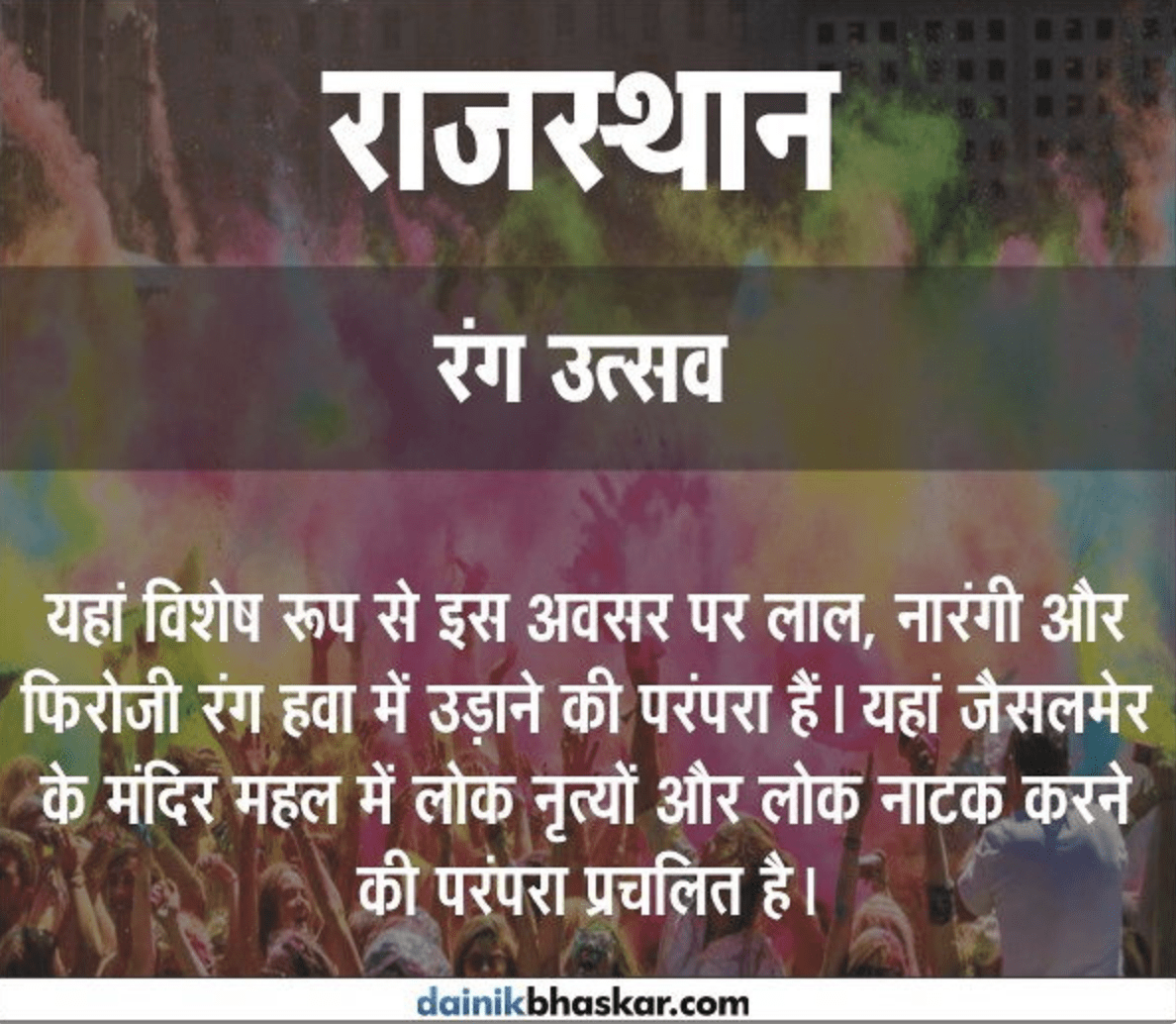
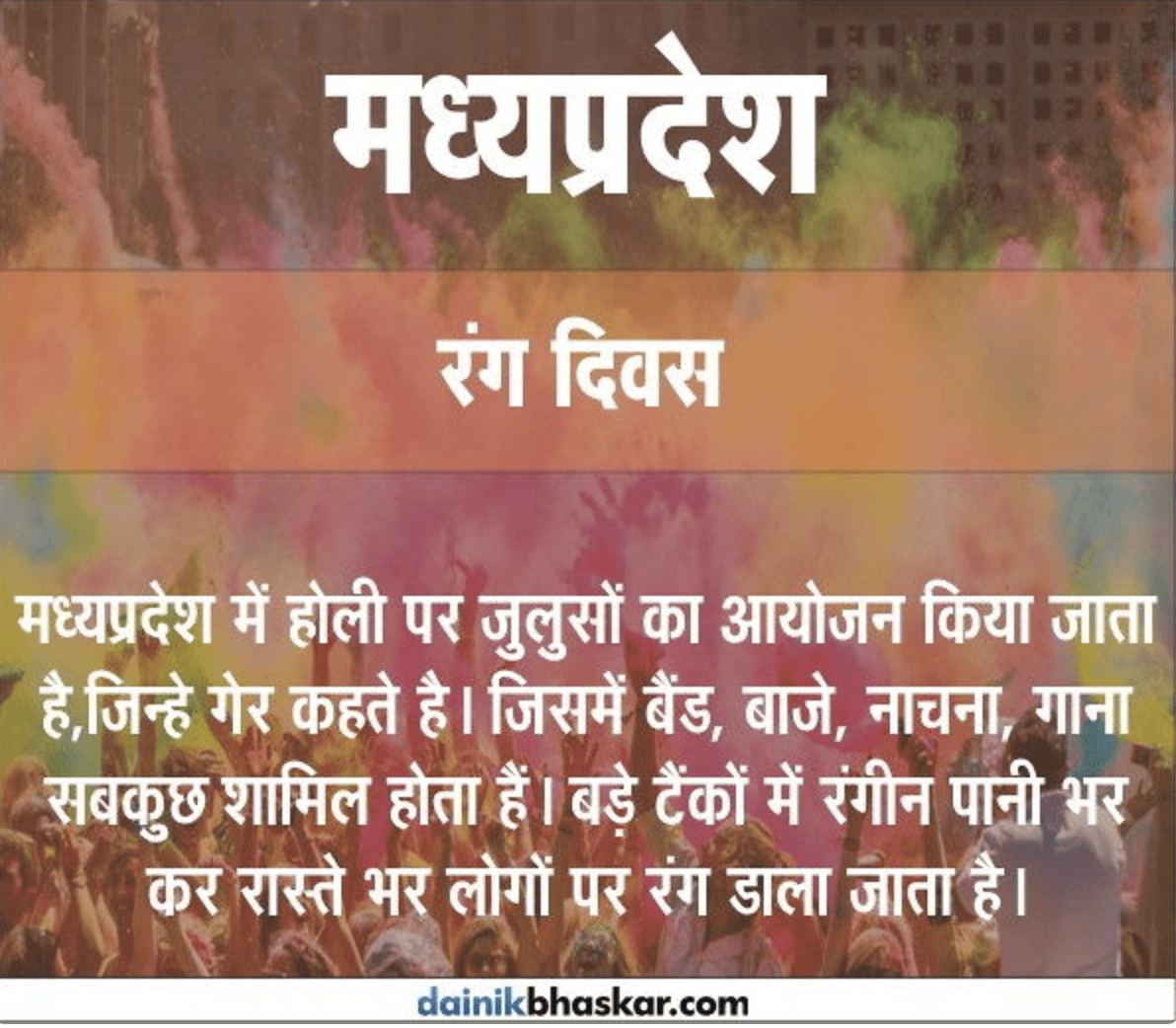
5. Teacher raises awareness about the use of passive and conjunct verbs. Students scan for them in their text and copy them. As a class, students fill out a google document with 3 columns (१। वस्तुएँ — लोग किन-किन चीज़ों का इस्तेमाल करते हैं, २। व्यवहार — लोग क्या-कया करते हैं, ३। विश्वास — लोग क्यों यह करते हैं )
[gview file=”https://bpb-us-e1.wpmucdn.com/wp.nyu.edu/dist/e/3394/files/2021/06/Holi-and-Passives.pptx”]
6. Final Product: Students are assigned a task by an editor of an online interactive magazine for young readers to prepare a slide show with voice over on how Holi is celebrated in India. Students use of blank map of India and use at least twice the four new structures.
Extra Materials for homework and continuation:
- https://www.youtube.com/watch?v=U6eylMFG-s8 (The Story of Prahlada and Holika for kids)
- https://www.youtube.com/watch?v=kbJbb53sp2c (History of Holi, 2.45-5.30)
- https://www.youtube.com/watch?v=64qkf65nmYU (Safe Holi)
- https://www.youtube.com/watch?v=pLoxs1ojFqY (Safe Holi)
